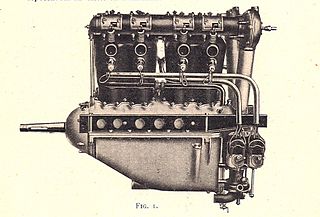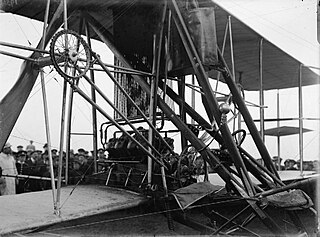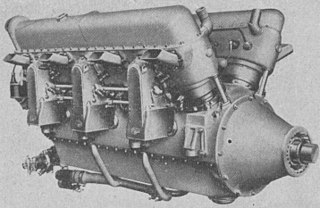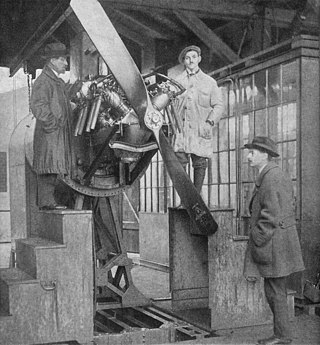
The straight-eight engine or inline-eight engine is an eight-cylinder internal combustion engine with all eight cylinders mounted in a straight line along the crankcase. The type has been produced in side-valve, IOE, overhead-valve, sleeve-valve, and overhead-cam configurations.

A U engine is a piston engine made up of two separate straight engines placed side-by-side and coupled to a shared output shaft. When viewed from the front, the engine block resembles the letter "U".

An overhead camshaft (OHC) engine is a piston engine in which the camshaft is located in the cylinder head above the combustion chamber. This contrasts with earlier overhead valve engines (OHV), where the camshaft is located below the combustion chamber in the engine block.

The Renault 8G was a family of French liquid-cooled V-8 aero engines of the World War I era that produced from 140 hp (100 kW) to 190 hp (140 kW).

The Green D.4 was a four-cylinder watercooled inline piston engine produced by the Green Engine Co in the UK in 1909. It produced about 60 hp (45 kW) and played an important role in the development of British aviation before World War I.

E.N.V. was an early manufacturer of aircraft engines, originally called the London and Parisian Motor Company, their first model appearing in 1908. E.N.V. engines were used by several pioneer aircraft builders and were produced in both France and the UK until about 1914. They subsequently specialised in camshafts and bevel gear manufacture until 1968 when the name was lost.

The Lorraine 12H Pétrel was a French V-12 supercharged, geared piston aeroengine initially rated at 370 kW (500 hp), but later developed to give 640 kW (860 hp). It powered a variety of mostly French aircraft in the mid-1930s, several on an experimental basis.

The Asso XI was a family of water-cooled, supercharged V12 piston aeroengines produced in the 1930s by Italian manufacturer Isotta Fraschini, and fitted on a number of aircraft types built by CANT, Caproni and others.
The CNA C-7 was a small nine-cylinder supercharged, geared, single row radial engine designed in Italy in the early 1930s. Three light aircraft class world altitude records were set by the CNA C-7 powered Fiat AS.1 and CNA Eta.

The Austin 25-30 is a motor car. It was the first automobile produced by newly established British car manufacturer Austin.

The Fiat AN.1 was an experimental Italian water-cooled diesel straight six cylinder aircraft engine from the late 1920s.

The Hispano-Suiza 18R was an eighteen cylinder high performance water-cooled piston engine, in an 80° W or broad arrow layout, for use in racing aircraft, built in France during the latter half of the 1920s.

The Renault 100 hp, or 12B, aircraft engine from 1912 was a twelve-cylinder, air cooled 60° vee engine built by the French Renault company.

The Renault 130 hp V-12 aircraft engine is a twelve-cylinder, air cooled 90° vee engine built by the French Renault company.

The De Dion-Bouton 78 hp, typically referred to as De Dion-Bouton 80 hp, was an eight-cylinder, air cooled vee aircraft engine that has been built by De Dion-Bouton.

The De Dion-Bouton 130 hp aircraft engine, also referred to as De Dion-Bouton 12B, was a twelve-cylinder, air cooled vee aircraft engine that has been built by De Dion-Bouton.
The Rapp 100 hp was a four-cylinder, SOHC valvetrain liquid-cooled inline aircraft engine built by Rapp Motorenwerke. The engine originated from Karl Rapp's earlier 90 hp four-cylinder that he had designed at the Flugwerk Deutschland GmbH for the 1912/13 Kaiserpreis aircraft engine contest.

The Rapp 125/145 hp, also referred to as Rapp Rp II, was a water-cooled 90° V-8 aircraft engine built by Rapp Motorenwerke in 1915.

The Rapp 200 hp was a water-cooled 90° V-8 aircraft engine built by Rapp Motorenwerke.

The Renault 50/60 hp aircraft engines were a series of air cooled 90° V-8 engines with a bore and stroke of 90 mm × 120 mm built by the French Renault company in the years from 1908 to about 1911.




















